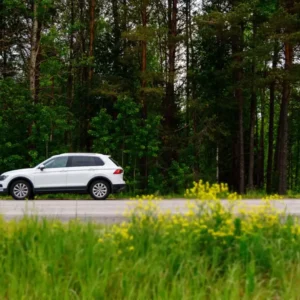If you’ve been there, you know the feeling. You’re driving, maybe late at night, and suddenly there’s a scrap of tire or a tree branch on the road that you didn’t see, and you hit it. The damage isn’t huge, but it’s still frustrating. Good thing you have insurance to cover it, right?
Well, here’s the thing: in certain scenarios, like hitting debris on the road or being the victim of a hit-and-run, you may not be at-fault, but you’ll still be responsible for paying your deductible.
How collision insurance works
Standard car insurance doesn’t cover at-fault damages or collisions with debris, stationary objects, road fixtures, and in certain scenarios, other cars. This is where collision insurance comes in. However, it’s optional coverage, meaning that unless you’ve elected to add it to your policy it won’t be included.
Collision insurance covers damages to your vehicle if you’re at fault in an accident. This includes hitting another car or a stationary object, like a street lamp or guardrail, and even situations like rolling into a ditch. It also applies if you slip on icy roads or hit unexpected debris. With collision insurance, you need to pay your deductible before your insurance covers the rest of the repairs.
This also applies in hit-and-runs. While uninsured motorist coverage is mandatory in all Ontario auto insurance policies, it only insures against collisions where the other driver has been identified but is underinsured or uninsured. In a hit-and-run, the other driver cannot be identified, and so you would only be covered for the damages if you had collision insurance.
As mentioned, with collision coverage you’ll need to pay a deductible. Common deductible amounts range between $250-$1,500. Your insurer will cover the damages minus your deductible. Choosing a higher deductible will usually lower your insurance premiums but will mean a smaller payout after a claim.
Scenarios where you may be required to pay your deductible

It can be extremely frustrating to find yourself in a situation where you thought your insurance would cover you, only to learn you’ll be required to pay your deductible. And if you don’t have collision insurance, you won’t have any protection at all.
Here are some example scenarios that we’ve seen at Mitch where the driver was either required to pay their deductible, or found they didn’t have coverage at all:
Debris on the road
Debris on the road can be hard to avoid if there’s poor visibility, it’s winter, or you’re driving at night. One of the more common situations we’ve seen at Mitch is when salt and sand trucks leave piles of debris on the road. When it’s dark, drivers can hit these piles, causing severe damage to their vehicles.
Because this was a stationary object struck on the road, coverage would apply through your collision insurance, and you’d have to pay your deductible. Your insurance rate may also be impacted, or you could wind up losing your accident forgiveness waiver (which prevents your first claim from raising your insurance rates).
Keep this in mind: if you hit something on the road, it’s considered a collision and falls under your collision insurance. We’ve had clients hit all sorts of objects on the road, including chunks of tire, construction cones, landscaping material, and more. Unfortunately, even though it wasn’t your fault that the debris was on the road, you’ll end up paying for it. With insurance you’re expected to exercise “care and control,” even if you didn’t see the debris or it had flown off a truck earlier.
Hit-and-run
This one’s a frustrating one for a lot of people, but hit-and-runs aren’t covered by uninsured auto insurance, or any other coverage except collision insurance. Luckily, you’re not considered at-fault for these incidents, but in many cases you’ll be responsible for your deductible. Unless you can somehow identify the driver (check security footage if possible), you’ll need to rely on your collision coverage or pay out of pocket for the damages.
Hit-and-run accidents might not impact your insurance rates if you report them to the police. If the other driver is later found, you can inform your insurance company and potentially end up having your damages paid for without being responsible for your deductible.
Single vehicle hitting a patch of ice
Weather events are another point of contention. Even though you didn’t cause the icy road conditions, insurance expects you to exercise care and control. If your car slides into a ditch because of ice, that’s technically an example of you not doing that and you’d be considered at fault. Again, this would fall under your collision insurance, and you’d be required to pay your deductible.
Vehicles and flood damage
Flooding is one of the biggest causes of insured loss in Ontario and affects both homes and cars. Many policyholders are surprised to learn that they’ll need to pay their deductibles for flood damage to their vehicles. However, depending on the cause of the flooding, there are two types of coverage that might apply to the damage.
If you drive into flood water and your vehicle gets damaged, it will be covered under collision insurance, because you intentionally put your car into that situation. As with the previous scenarios, you’ll have to pay your deductible and your insurance rates will probably go up.
Flood damage is covered under comprehensive insurance if you didn’t put the car in that situation. For example, if flooding in your underground parking damages your car. Like collision, comprehensive insurance is optional and comes with a deductible, plus it could increase your rates.
Tips for collision and comprehensive damages
So how do you avoid scenarios like these and save money? Unfortunately, if you hit something on the road or are involved in a hit-and-run, it’s unlikely you’ll be able to convince your insurance provider that you aren’t responsible for paying your deductible. In rare instances, you may be able to find fault with a third-party, such as having a municipality take accountability for a construction site leaving cones out on the road which damage your car, but it can be a long, arduous process to do so. With hit-and-runs, it’s always best to report the incident to the police and check security camera footage where possible, but sometimes the person responsible for the accident is never found.
Our advice? If you can, pay for smaller damage yourself instead of filing a claim. If it’s only a few scratches or other minor cosmetic damage, financially you’re much better off handling it on your own rather than facing the deductible cost plus the potential rate increase.
Also, be aware of what you’re covered for. All of the scenarios above are insurable under collision and comprehensive coverage, which are both optional but can cover a lot. Ask your broker about what you’re covered for if you’re unsure.
Give us a call if you have questions about claims, collision and comprehensive insurance, or anything else. We’d be happy to put your mind at ease.
Looking for car insurance?
Speak with a Mitch Insurance broker today to get a quote on Ontario auto insurance.
Call now
1-800-731-2228







